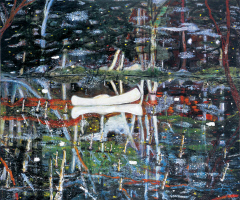Personal stories as the source of strong art concepts
Creativity implies the existence of a basic concept behind the work of art. A concept is simply an idea. As artists, we aim to come up with an innovative idea that fosters our creation. Good art clearly manifests the new and, of course, the self. Nevertheless, old concepts are there to be shared; they may be borrowed from the past to be re-polished, re-analyzed, and re-conveyed. Yes, you may paint canoes on lakes! In 2007, Peter Doig’s White Canoe sold at auction for nearly $12 million, making it the most expensive work by a living Scottish-Canadian painter.
When looking for a new subject in a painting, your own personal stories may give you the key to a strong concept. Stories are threads that unite us. We all have stories: some to keep, some to share, at the table or on a painting. Some people are talkative, expansive and loquacious; others are reserved and cautious with their words and stories. Some talk exclusively about their children and dogs, others about a vast array of topics. Some feel comfortable talking about their sex life at the table or depicting it in a painting, some would not even think about doing so. Not saying the truth might be a lie for one person, yet be a wise, diplomatic choice of the moment for another person. Stories shared among work colleagues might be less interesting than the licentious anecdotes shared among dearest friends. We all have stories—interesting stories, happy stories, strange stories, sad stories, bawdy stories, but when the story ends what remains alive are the emotions that have been awakened in us. When painting a personal story, we need to find a compelling idea or concept that allows us to awaken these same emotions in our spectators. Our approaches to the subject, our style, our technique and our use of colours to tap into emotions are our chosen mechanisms for expressing our concept or idea in a work of art.
As Alberti wrote in his Della Pittura, in a painting there is shape and content; the latter translated by istoria, the “story.” For us, the istoria is most important. By manipulating and painting your own stories you will learn how to master the technique—something that may have helped many self-taught artists. Your story may resemble my story, but since everyone is different, our choices of technique, colours, stroke, etc. will differ. Make an inventory of the most engaging, true stories of your life; it will help you to know yourself better and produce more personal works. Take the advantage of being unique to differentiate your paintings from the thousands others. We shall always remember that stories link us all.
This post is a follow-up of:
http://walkthearts.wordpress.com/2012/03/07/the-three-cs-in-art-concept-content-and-context-1/



0 Comments
Trackbacks/Pingbacks